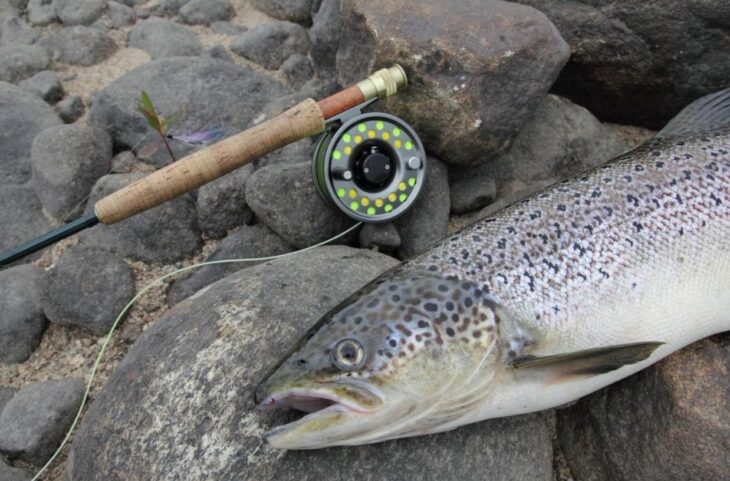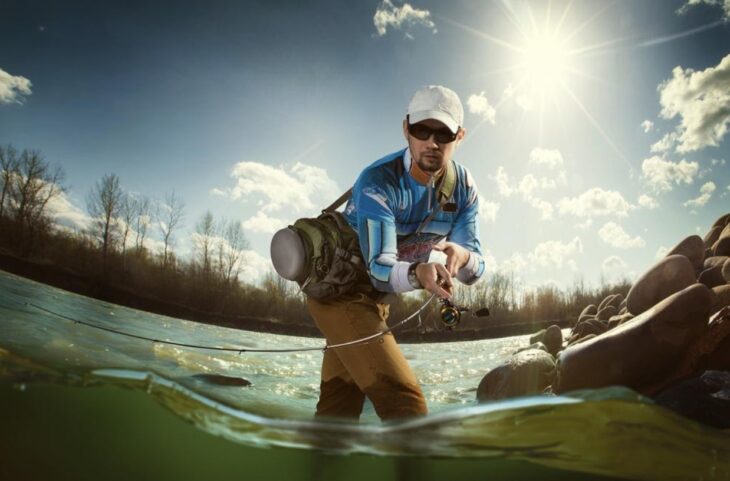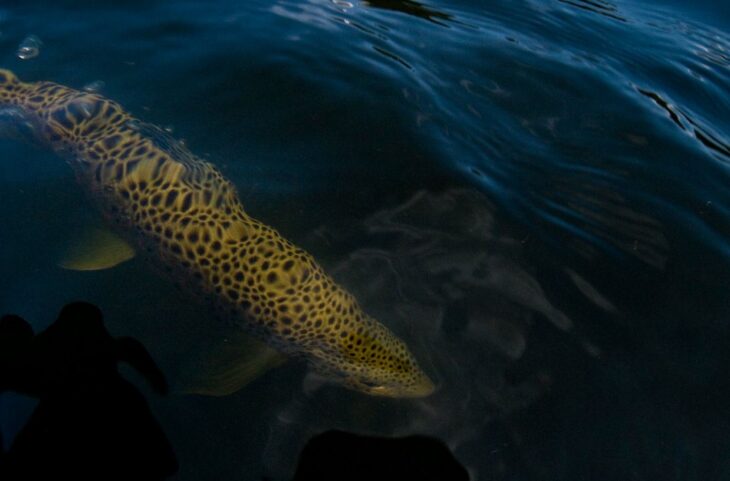No matter what level angler you are, there’s always room for improvement. Picking up new skills in a favorite sport is a fun way to level up. Study these new skills before your next big fishing trip and practice them when you go.
For anglers who are looking for a new challenge, here are five fishing skills to master to make your next fishing trip even more enjoyable.
Contents
1. Try Dapping
Dapping is a technique that accurately mimics the movement of a caddis fly or mayfly when it is just touching the water’s surface to deposit some eggs. It’s a simple technique, and it also can be very effective. It’s also incredibly useful when you don’t have a lot of room to maneuver.
To dap with a dry fly, stand about a rod’s length away from the shore. Using just the leader through the rod tip, lay your dry fly on top of the water and drift for a few inches and then pick it up and place it down again.
You may be able to hook some fish in an otherwise unfishable spot. If you don’t have enough room for a full backcast with your fly rod, try dapping. The results may surprise you. Click here for a selection of the best crankbait rods on the market.

Source: gdvcom/Shutterstock.com
2. Cast at Moving Fish
When fly fishing in fast-moving water or trying to hook a swimming fish, you have to take into account the current, the speed at which the fish travels and the length of your cast. You also have to make these calculations quickly before the school is gone.
Here’s the challenge when you finally get out on the water–drop your fly down in front of a swimming fish at a distance of 50 feet. To accomplish this, you will use a double-haul cast. Many believe that this cast is mainly for saltwater angling, but a double haul can help you catch some trout on a fast-moving river. This cast can help you cast farther and deal with variables like wind and current.
Before you try this skill out on your next fishing trip, you can practice a double haul cast at home, preferably on a sturdy platform like a picnic table. Pull about 50 feet of line from your reel and arrange it by your left foot (if you are a right-handed caster), making sure that it will not tangle. This may take some rearranging and re-stacking of your line. Try holding the end that exits the reel with your pinky and pull the rest of the line through, stacking it tangle-free.
Once your line is stacked, pull 10 feet of line through the tip. Hold the fly at the hook bend with your reel hand, point your tip up, shoot off a roll cast and let go of the fly after you snap your rod forward. Your next moves–back cast, false cast and second backcast–should all be made with hauls. After the second back cast, shoot your fly.
3. Walk the Dog
This tactic is handy for topwater fishing and will draw strikes from large and smallmouth bass, stripers, bluefish and even tuna. The movement during the line retrieve creates a zigzag motion across the water and works best with a spook-style lure.
To execute, cast, keeping your tip low to the water. Then snap your rod tip downwards sharply, returning it immediately to the neutral position. This allows slack in the line and your dry lure will drift a few inches. Snap the rod tip down again and the lure will jerk back.
Continue this rhythm to set up a zigzag pattern across the water and be mindful of timing. The fish will prefer certain cadences over others, so keep adjusting the zigzag rhythm until you get a strike.

Source: Rocksweeper/Shutterstock.com
4. Shoot for Crappies
Crappies love docks, which provide them with baitfish, cover and shade. The other bonus for crappies is that it is challenging to cast between pilings, other boats, boat lifts and more. To get to where all the crappies are assembling, you’ll have to change your rod into a bow temporarily.
Use a medium-light or ultra-light rod with high visibility monofilament in the 4- to 6-pound range. Use a crappie jig with a soft body and you’re all set to shoot with an open face spinning reel.
To create a bend in your rod that will provide the necessary tension to shoot your lure underneath the dock, open the bail and release enough line so your lure hangs down to the bottom rod guide. Catch the line with your trigger finger on your hand and press it against your rod.
Grab the jig head with your free hand, making sure the hook’s points are pointed up and out, and pull it to the side while your rod tip remains pointed at the place you want to cast. This creates a definite bend in your rod.
Keep your rod tip low and, when you release the lure, snap the tip up to ensure that it doesn’t get caught on your rod. Release the line and let the line play out as your lure slingshots into the shady depths underneath the dock. It should start skipping right before it reaches its destination.
5. Fish Deep Water
If you’re going for walleyes or trout hanging out at 40 to 60 feet depths, you’ll need a particular technique and performance fishing gear to get the job done. Light lines slice through the water while weight will pull your lure down deep.
You’ll need a 6-pound mono or 8-pound braid tied onto a three-way swivel. To another eye, tie on three feet of mono and then a weight of one to three ounces. Tie three more feet of mono to the other eye and tie a light lure, like a spoon, at its end.
The challenge is to get the lure deep without getting tangled on the way down. Once you’ve lowered your rig into the water, ease the line out a few feet at a time, and let the line grow taut as the boat moves forward.
When your forward momentum slows a bit, set the bail, get some speed up, flip the bail and let out more line. When you feel the weight hit bottom, reel it in about a foot and move your boat in a zigzag to attract those deep-dwelling fish.

Source: Gink and Gasoline
Final Thoughts
One of the real joys of fishing is that there is always something new to learn. Whether it’s new flies, new techniques or new locales, a fishing charter with Poseidonfishingcharters.
As you’re waiting for your favorite fish to spawn, pick up some new skills to try out when you hit the river or lake this season.
